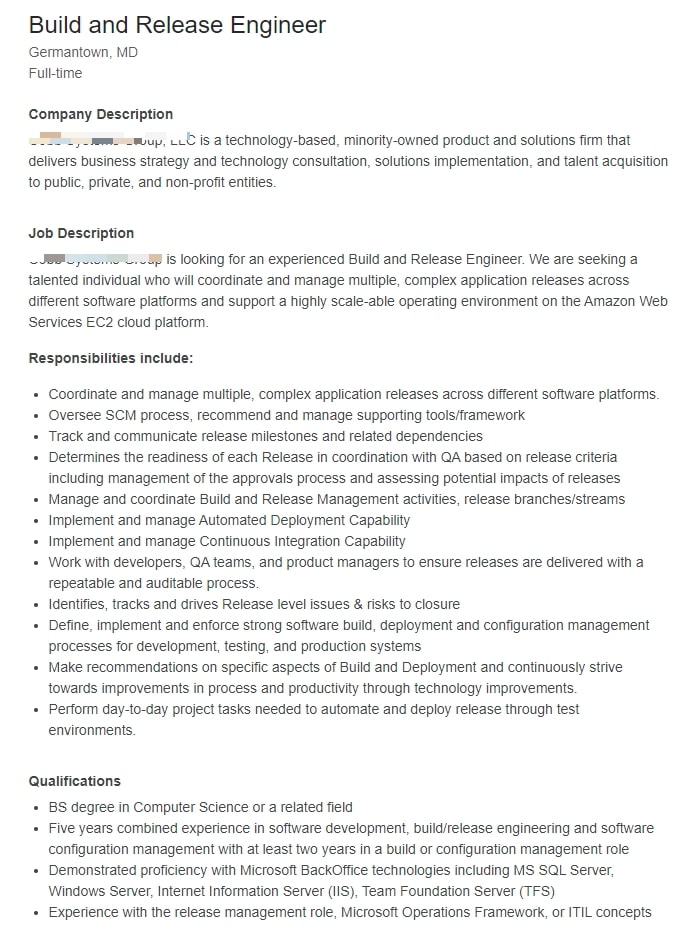So you want to build applications that work every time? In that case, you’ll need both a build and release engineer and a DevOps engineer on your team. While some circles use the terms interchangeably, the roles are unique in several ways.
Understanding the difference between build and release engineering and DevOps engineering will help you know how to fill each role, as well as how each contributes to the overall IT team.
There are three major differences between a ‘DevOps build’ and ‘build and release engineering’:
- While build and release engineers focus on building stable software for a specific purpose, DevOps engineers optimize the infrastructure needed to make that happen
- As a build engineer builds, tests, and deploys ready code changes, the DevOps engineer helps automate the process to minimize errors, time, and release cycles involved
- While the DevOps engineer works to ingrain a culture of continuous collaboration and communication to ensure efficient deployments, the release engineer works out the technical bits of building and releasing reliable software.
Some organizations prefer to hire specialists in DevOps build and release engineering professionals to improve their workflows, but there’s value in separating out both engineers’ roles.
They both take a leadership role in the way your organization delivers customer satisfaction on an ongoing basis, which is why it’s critical to ensure both roles are accounted for on your development teams.
Interested in learning more? Check out these blogs:
What Does a Build and Release Engineer Do?
A build and release engineer is a computer software professional who works in a team of developers, system operators, and project managers to meet software engineering build and release requirements. They ensure applications work as expected by testing and improving them.
Modern build and release engineers conduct software development work on an ongoing basis as more software companies and enterprises embrace continuous integration and continuous delivery (CI/CD) practices.
The systems engineer plays a major role in build engineering and release management, which involves version control, development testing, as well as tagging and tracking bugs to ensure new code releases improve the entire end product/application for its specific role in the organization.
Some specific build and release engineering roles and responsibilities include:
- Working with developers and using various scripting languages to build software from scratch, test it, and deploy it for a specific use case or client
- Keeping track of improvements
- Using crash and bug reports or logs to identify areas that need improvement
- Recommending, directing and re-testing fixes to make sure the software works reliably
- Recording helpful information, such as version details, the release process, and post-deployment recommendations
- Ensuring released versions are up-to-date, stable, and serve their purpose as expected
As you might expect, the role usually involves lots of programming, testing, and deploying updates in short cycles on a continuous delivery (CD) basis.
Here’s an example of a build and release job description:

As you can see, the build and release engineer takes more of an authority role among developers and other technical IT staff, which is quite common for this type of position.
Given all that, how are DevOps engineers different from build and release engineering consultants?
What Does a DevOps Engineer Do?
The modern DevOps engineer’s daily job is to ensure workflows between developers, system operators, and project managers don’t run into any issues that could affect the team’s ability to deliver a reliable, timely, and efficient application that serves a client’s purpose.
To do that, DevOps engineers do the following:
- They pioneer collaboration and smooth out feedback loops across the entire IT department
- They involve software clients early in the development process to ensure everyone knows how the final product should look and work
- They ensure different teams working on various aspects of the same project use continuous feedback loops for faster deployments
- They help improve infrastructure design to improve collaborations, communications, and, ultimately, release cycles
- They monitor the latest releases to ensure they work as expected and are secure
- Otherwise, they log and report issues back to specific teams or engineers for improvement
- Ultimately, DevOps implements CD by automating the process of deploying qualified code changes to production in the shortest time possible
Here, you can notice how DevOps engineers take a cross-functional leadership role among all IT staff to help release updates as efficiently as possible.
For this reason, DevOps engineers need to be proficient in DevOps tools such as Jenkins for automation, JIRA for project management, Kubernetes for containerization, and Raygun for monitoring and reporting issues.
At Simpat Tech, we understand that hiring, training, and retaining highly skilled in-house IT staff at multiple levels isn’t always workable. Our team enhancement solutions can help you create reliable software more efficiently by fulfilling both build and release engineering and DevOps engineer roles. Reach out today for help optimizing your team’s current build and release process.
Image Source: Pexels